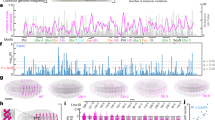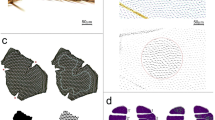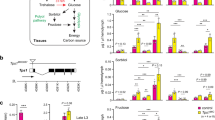Abstract
The heat-shock protein Hsp90 supports diverse but specific signal transducers and lies at the interface of several developmental pathways. We report here that when Drosophila Hsp90 is mutant or pharmacologically impaired, phenotypic variation affecting nearly any adult structure is produced, with specific variants depending on the genetic background and occurring both in laboratory strains and in wild populations. Multiple, previously silent, genetic determinants produced these variants and, when enriched by selection, they rapidly became independent of the Hsp90 mutation. Therefore, widespread variation affecting morphogenic pathways exists in nature, but is usually silent; Hsp90 buffers this variation, allowing it to accumulate under neutral conditions. When Hsp90 buffering is compromised, for example by temperature, cryptic variants are expressed and selection can lead to the continued expression of these traits, even when Hsp90 function is restored. This provides a plausible mechanism for promoting evolutionary change in otherwise entrenched developmental processes.
This is a preview of subscription content, access via your institution
Access options
Subscribe to this journal
Receive 51 print issues and online access
$199.00 per year
only $3.90 per issue
Buy this article
- Purchase on Springer Link
- Instant access to full article PDF
Prices may be subject to local taxes which are calculated during checkout








Similar content being viewed by others
References
Morimoto, R. I., Kline, M. P., Bimston, D. N. & Cotto, J. J. The heat-shock response: regulation and function of heat-shock proteins and molecular chaperones. Essays Biochem. 32, 17–29 (1997).
Nathan, D. F., Vos, M. H. & Lindquist, S. In vivo functions of the Saccharomyces cerevisiae Hsp90 chaperone. Proc. Natl Acad. Sci. USA 94, 12949–12956 (1997).
Rutherford, S. L. & Zuker, C. S. Protein folding and the regulation of signaling pathways. Cell 79, 1129–1132 (1994).
Smith, D. F. Dynamics of heat shock protein 90-progesterone receptor binding and the disactivation loop model for steroid receptor complexes. Mol. Endocrinol. 7, 1418–1429 (1993).
Nathan, D. F. & Lindquist, S. Mutational analysis of Hsp90 function: interactions with a steroid receptor and a protein kinase. Mol. Cell. Biol. 15, 3917–3925 (1995).
Jakob, U., Lilie, H., Meyer, I. & Buchner, J. Transient interaction of Hsp90 with early unfolding intermediates of citrate synthase. Implications for heat shock in vivo. J. Biol. Chem. 270, 7288–7294 (1995).
Freeman, B. C. & Morimoto, R. I. The human cytosolic molecular chaperones hsp90, hsp70 (hsc70) and hdj-1 have distinct roles in recognition of a non-native protein and protein refolding. EMBO J. 15, 2969–2979 (1996).
Picard, D. et al. Reduced levels of hsp90 compromise steroid receptor action in vivo. Nature 348, 166–168 (1990).
Holley, S. J. & Yamamoto, K. R. Arole for Hsp90 in retinoid receptor signal transduction. Mol. Biol. Cell. 6, 1833–1842 (1995).
Stepanova, L., Leng, X., Parker, S. B. & Harper, J. W. Mammalian p50Cdc37 is a protein kinase-targeting subunit of Hsp90 that binds and stabilizes Cdk4. Genes Dev. 10, 1491–1502 (1996).
Xu, Y. & Lindquist, S. Heat-shock protein hsp90 governs the activity of pp60v-src kinase. Proc. Natl Acad. Sci. USA 90, 7074–7078 (1993).
Ali, A., Bharadwaj, S., O'Carroll, R. & Ovsenek, N. HSP90 interacts with and regulates the activity of heat shock factor 1 in Xenopus oocytes. Mol. Cell. Biol. 12, 4949–4960 (1998).
Zou, J., Guo, Y., Guettouche, T., Smith, D. F. & Voellmy, R. Repression of heat shock transcription factor HSF1 by HSP90 (HSP90 complex) that forms a stress-sensitive complex with HSF1. Cell 94, 471–480 (1998).
Cutforth, T. & Rubin, G. M. Mutations in Hsp83 and cdc37 impair signaling by the sevenless receptor tyrosine kinase in Drosophila. Cell 77, 1027–1036 (1994).
Dickson, B. J., van der Straten, A., Dominguez, M. & Hafen, E. Mutations modulating Raf signaling in Drosophila eye development. Genetics 142, 163–171 (1996).
van der Straten, A., Rommel, C., Dickson, B. & Hafen, E. The heat shock protein 83 (Hsp83) is required for Raf-mediated signalling in Drosophila. EMBO J. 16, 1961–1969 (1997).
Whitesell, L., Mimnaugh, E. G., De Costa, B., Myers, C. E. & Neckers, L. M. Inhibition of heat shock protein HSP90-pp60v-src heteroprotein complex formation by benzoquinone ansamycins: essential role for stress proteins in oncogenic transformation. Proc. Natl Acad. Sci. USA 91, 8324–8328 (1994).
Falconer, D. S. & Mackay, T. F. C. Introduction to Quantitative Genetics (Longman, Harlow, 1996).
Waddington, C. H. Canalization of development and the inheritance of acquired characters. Nature 150, 563–565 (1942).
Wagner, G. P. Coevolution of functionally constrained characters: prerequisites for adaptive versatility. Biosystems 17, 51–55 (1984).
Kauffman, S. A. The Origins of Order: Self Organization and Selection in Evolution (Oxford Univ. Press, New York, 1993).
Raff, R. A. The Shape of Life: Genes, Development, and the Evolution of Animal Form (Univ. Chicago Press, Chicago, 1996).
Gerhart, J. & Kirschner, M. Cells, Embryos, and Evolution: Toward a Cellular and Developmental Understanding of Phenotypic Variation and Evolutionary Adaptability (Blackwell, Malden, 1997).
Waddington, C. H. Genetic assimilation of an acquired character. Evolution 7, 118–126 (1953).
Rendel, J. M., Sheldon, B. L. & Finlay, D. E. Canalisation of development of scutellar bristles in Drosophila by control of the scute locus. Genetics 52, 1137–1151 (1965).
Polaczyk, P. J., Gasperini, R. & Gibson, G. Naturally occurring genetic variation affects Drosophila photoreceptor determination. Dev. Genes Evol. 207, 462–470 (1998).
Waddington, C. H. Genetic assimilation of the bithorax phenotype. Evolution 10, 1–13 (1956).
Gibson, G. & Hogness, D. S. Effect of polymorphism in the Drosophila regulatory gene Ultrabithorax on homeotic stability. Science 271, 200–203 (1996).
Wade, M. J., Johnson, N. A., Jones, R., Siguel, V. & McNaughton, M. Genetic variation segregating in natural populations of Tribolium castaneum affecting traits observed in hybrids with T. freemani. Genetics 147, 1235–1247 (1997).
De Jong, G. & Scharloo, W. Environmental determination of selective significance or neutrality of amylase variants in Drosophila melanogaster. Genetics 84, 77–94 (1976).
Dykhuizen, D. & Hartl, D. L. Selective neutrality of 6PGD allozymes in E. coli and the effects of genetic background. Genetics 96, 801–817 (1980).
Kimura, M. The Neutral Theory of Molecular Evolution (Cambridge Univ. Press, Cambridge, New York, 1983).
Simon, M. A., Bowtell, D. D., Dodson, G. S., Laverty, T. R. & Rubin, G. M. Ras1 and a putative guanine nucleotide exchange factor perform crucial steps in signaling by the sevenless protein tyrosine kinase. Cell 67, 701–716 (1991).
Lindsley, D. L. & Zimm, G. G. The Genome of Drosophila melanogaster (Academic, San Diego, 1992).
Aligue, R., Akhavan-Niak, H. & Russell, P. Arole for Hsp90 in cell cycle control: Wee1 tyrosine kinase activity requires interaction with Hsp90. EMBO J. 13, 6099–6106 (1994).
Futuyma, D. J. Evolutionary Biology Sinauer, Sunderland, (1998).
Xu, Y., Singer, M. & Lindquist, S. Maturation of c-src as a kinase and as a substrate is dependent on Hsp90. Proc. Natl Acad. Sci. USA (in the press).
Acknowledgements
We thank M. Wade for discussions, J. Segre for assistance in devising the PCR genotyping strategy, laboratories that supplied fly strains (see Table 2), and T. Mackay for insight into the quantitative analysis of threshold traits.
Author information
Authors and Affiliations
Supplementary information
Supplementary Information
Supplementary Information (PDF 16 kb)
Rights and permissions
About this article
Cite this article
Rutherford, S., Lindquist, S. Hsp90 as a capacitor for morphological evolution. Nature 396, 336–342 (1998). https://doi.org/10.1038/24550
Received:
Accepted:
Issue Date:
DOI: https://doi.org/10.1038/24550
This article is cited by
-
The difference of intestinal microbiota composition between Lantang and Landrace newborn piglets
BMC Veterinary Research (2023)
-
Hsp90 is a potential risk factor for ovarian cancer prognosis: an evidence of a Chinese clinical center
BMC Cancer (2023)
-
A dual sgRNA library design to probe genetic modifiers using genome-wide CRISPRi screens
BMC Genomics (2023)
-
An Updated Review on KRAS Mutation in Lung Cancer (NSCLC) and Its Effects on Human Health
Applied Biochemistry and Biotechnology (2023)
-
Immune Stimulation via Wounding Alters Chemical Profiles of Adult Tribolium castaneum
Journal of Chemical Ecology (2023)
Comments
By submitting a comment you agree to abide by our Terms and Community Guidelines. If you find something abusive or that does not comply with our terms or guidelines please flag it as inappropriate.



